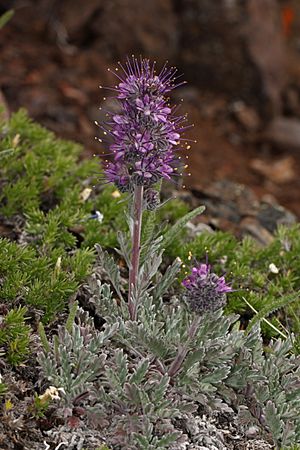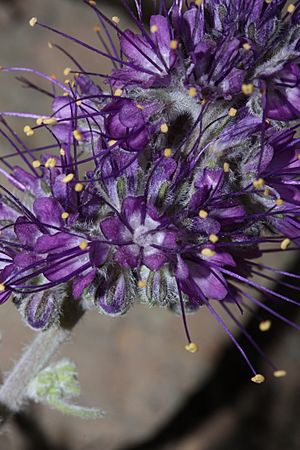Silky phacelia facts for kids
Phacelia sericea, also known as the silky phacelia or blue alpine phacelia, is a beautiful wild flower found only in western North America. It's a perennial plant, meaning it lives for more than two years. You won't find it everywhere; it usually grows in high mountain areas, like subalpine and alpine zones. These are places where forests start to thin out or where there are no trees at all, often among rocks and sand. The name sericea comes from a Latin word meaning "silky," which describes the fine, soft hairs on its leaves and stems.
Quick facts for kids Silky phacelia |
|
|---|---|
 |
|
| P. sericea ssp. sericea | |
| Scientific classification | |
| Genus: |
Phacelia
|
| Species: |
sericea
|
| Subspecies | |
|
P. sericea ssp. ciliosa (Rydb.) Gillett |
|
Contents
What is Silky Phacelia?
The silky phacelia plant has several stems that grow straight up or slightly angled. They can reach about 60 centimeters (2 feet) tall. The plant grows from a strong, woody base with a main root called a taproot.
Its leaves are divided into many smaller parts, like a feather. Some parts might be deeply cut, while others are smooth. The leaves at the bottom of the plant are a bit bigger. They also have longer stems (petioles) and stay on the plant longer.
Both the leaves and stems are usually covered with soft, silvery, silky hairs. This is where the plant gets its name!
Silky Phacelia Flowers
The flowers of the silky phacelia grow in tight clusters at the top of the stems. These clusters look a bit like a bottle brush. The flowers are bell-shaped and can be dark blue or purple. Each flower is about 4 to 6 millimeters wide.
The flowers have hairs both inside and out. Long, thin parts called filaments stick out from the flower. They are two to three times longer than the flower petals. This gives the whole flower cluster a fuzzy look. The tips of these filaments, called anthers, are bright yellow or orange.
After the flowers bloom, they produce small fruits. These fruits are capsules with two chambers. Each capsule holds about 8 to 18 seeds.
Where Silky Phacelia Grows
This plant likes open, well-drained slopes in mountain areas. You can usually find it above 1,500 meters (about 4,900 feet) in elevation. It grows in the mountains of Vancouver Island and southern British Columbia.
You can also spot it in the Rocky Mountains, from Banff National Park in Canada all the way to southern Colorado. It's found in Olympic National Park and the Cascade Range in Washington.
Other places include the mountains of eastern Oregon, northern California, Idaho, Nevada, and Utah. The silky phacelia usually blooms from late May through the end of August.
Types of Silky Phacelia
Scientists recognize two main types, or subspecies, of silky phacelia.
- P. sericea ssp. ciliosa : This type is found from Oregon and California eastward to Wyoming and Colorado.
- P. sericea ssp. sericea : This type grows only in the Rocky Mountains, Alaska, British Columbia, and Washington.
The sericea subspecies is generally smaller and has more dense hairs. Its leaves are also narrower and have blunter tips. When both types grow in the same area, P. sericea ssp. ciliosa usually grows at lower elevations than P. sericea ssp. sericea.
Uses of Silky Phacelia
The Federal Highway Administration suggests using silky phacelia for landscaping along roadsides in Colorado. This helps to make the roadsides look nice with native plants.
It's a good idea to be careful when handling this plant. The long hairs on its flowers have been reported to cause skin irritation in some people.
See also
 In Spanish: Phacelia sericea para niños
In Spanish: Phacelia sericea para niños


